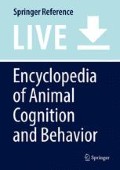References
Britton, A. R. C. (2001). Review and classification of call types of juvenile crocodilians and factors affecting distress calls. In Crocodilian biology and evolution (pp. 364–377). Chipping Norton: Surrey Beatty & Sons.
Campbell, H. W. (1973). Observations on the acoustic behavior of crocodilians. Zoologica, 58, 1–11.
Chabert, T., Colin, A., Aubin, T., Shacks, V., Bourquin, S. L., Elsey, R. M., et al. (2015). Size does matter: Crocodile mothers react more to the voice of smaller offspring. Scientific Reports, 5, 15547. https://doi.org/10.1038/srep15547.
Charlton, B. D., & Reby, D. (2016). The evolution of acoustic size exaggeration in terrestrial mammals. Nature Communications, 7, 12739.
Dinets, V. (2011). Effects of aquatic habitat continuity on signal composition in crocodilians. Animal Behaviour, 82(2), 191–201. https://doi.org/10.1016/j.anbehav.2011.04.012.
Garrick, L. D., & Lang, J. W. (1977). Social signals and behaviors of adult alligators and crocodiles. American Zoologist, 17(1), 225–239.
Garrick, L. D., Lang, J. W., & Herzog, H. A. (1978). Social signals of adult American alligators. Bulletin of the American Museum of Natural History, 160(3), 153–192.
Grigg, G. C., & Kirshner, D. (2015). Biology and evolution of crocodylians. Collingwood: CSIRO Publishing. https://doi.org/10.1146/annurev.ento.52.110405.091303.
Herzog, H. A., & Burghardt, G. M. (1977). Vocalization in juvenile crocodilians. Zeitschrift für Tierpsychologie, 44(3), 294–304.
Higgs, D. M., Brittan-Powell, E. F., Soares, D., Souza, M. J., Carr, C. E., Dooling, R. J., & Popper, A. N. (2002). Amphibious auditory responses of the American alligator (Alligator mississipiensis). Journal of Comparative Physiology A: Neuroethology, Sensory, Neural, and Behavioral Physiology, 188(3), 217–223. https://doi.org/10.1007/s00359-002-0296-8.
Hunt, R. H., & Watanabe, M. E. (1982). Observations on maternal behavior of the American alligator, Alligator mississippiensis. Journal of Herpetology, 16(3), 235–239.
Kofron, C. P. (1991). Courtship and mating of the Nile crocodile (Crocodylus niloticus). Amphibia-Reptilia, 12(1), 39–48. https://doi.org/10.1163/156853891X00310.
Leitch, D. B., & Catania, K. C. (2012). Structure, innervation and response properties of integumentary sensory organs in crocodilians. Journal of Experimental Biology, 215(23), 4217–4230. https://doi.org/10.1242/jeb.076836.
Passek, K. M., & Gillingham, J. C. (1999). Absence of kin discrimination in hatchling American alligators, Alligator mississippiensis. Copeia, 1999(3), 831–835. https://doi.org/10.2307/1447624.
Reber, S. A., Janisch, J., Torregrosa, K., Darlington, J., Vliet, K. A., & Fitch, W. T. (2017). Formants provide honest acoustic cues to body size in American alligators. Scientific Reports, 7(1816), 1–11. https://doi.org/10.1038/s41598-017-01948-1.
Reber, S. A., Nishimura, T., Janisch, J., Robertson, M., & Fitch, W. T. (2015). A Chinese alligator in heliox: Formant frequencies in a crocodilian. Journal of Experimental Biology, 218(15), 2442–2447. https://doi.org/10.1242/jeb.119552.
Riede, T., Li, Z., Tokuda, I. T., & Farmer, C. G. (2015). Functional morphology of the Alligator mississippiensis larynx with implications for vocal production. Journal of Experimental Biology, 218(7), 991–998. https://doi.org/10.1242/jeb.117101.
Somaweera, R., & Shine, R. (2012). Australian freshwater crocodiles (Crocodylus johnstoni) transport their hatchlings to the water. Journal of Herpetology, 46(3), 407–411.
Todd, N. P. M. (2007). Estimated source intensity and active space of the American alligator (Alligator mississippiensis) vocal display. The Journal of the Acoustical Society of America, 122(5), 2906–2915. https://doi.org/10.1121/1.2785811.
Vergne, A. L., Aubin, T., Martin, S., & Mathevon, N. (2012). Acoustic communication in crocodilians: Information encoding and species specificity of juvenile calls. Animal Cognition, 15(6), 1095–1109. https://doi.org/10.1007/s10071-012-0533-7.
Vergne, A. L., Aubin, T., Taylor, P., & Mathevon, N. (2011). Acoustic signals of baby black caimans. Zoology, 114(6), 313–320. https://doi.org/10.1016/j.zool.2011.07.003.
Vergne, A. L., Avril, A., Martin, S., & Mathevon, N. (2007). Parent-offspring communication in the Nile crocodile Crocodylus niloticus: Do newborns’ calls show an individual signature? Naturwissenschaften, 94(1), 49–54. https://doi.org/10.1007/s00114-006-0156-4.
Vergne, A. L., & Mathevon, N. (2008). Crocodile egg sounds signal hatching time. Current Biology, 18(12), R513–R514. https://doi.org/10.1016/j.cub.2008.04.011.
Vergne, A. L., Pritz, M. B., & Mathevon, N. (2009). Acoustic communication in crocodilians: From behaviour to brain. Biological Reviews, 84(3), 391–411. https://doi.org/10.1111/j.1469-185X.2009.00079.x.
Vliet, K. A. (1989). Social displays of the American alligator (Alligator mississippiensis). American Zoologist, 29(3), 1019–1031.
Vliet, K. A. (2001). Courtship behaviour of American alligators Alligator mississippiensis. In G. C. Grigg, F. Seebacher, & C. E. Franklin (Eds.), Crocodilian biology and evolution (pp. 383–408). Chipping Norton: Surrey Beatty & Sons.
Wang, X., Wang, D., Zhang, S., Wang, C., Wang, R., & Wu, X. (2009). Why do Chinese alligators (Alligator sinensis) form bellowing choruses: A playback approach. The Journal of the Acoustical Society of America, 126(4), 2082–2087. https://doi.org/10.1121/1.3203667.
Weldon, P. J., Scott, T. P., & Tanner, M. J. (1990). Analysis of gular and paracloacal gland secretions of the American alligator (Alligator mississippiensis) by thin-layer chromatography: Gland, sex, and individual differences in lipid components. Journal of Chemical Ecology, 16(1), 3–12. https://doi.org/10.1007/BF01021263.
Whitaker, R. (2007). The gharial: Going extinct again (gharial multi-task force). Iguana, 14(1), 24–33.
Whyte, A., Yang, Z.-C., Tiyanont, K., Weldon, P. J., Eisner, T., & Meinwald, J. (1999). Reptilian chemistry: Characterization of dianeackerone, a secretory product from a crocodile. Proceedings of the National Academy of Sciences, 96(22), 12246–12250.
Author information
Authors and Affiliations
Corresponding author
Editor information
Editors and Affiliations
Section Editor information
Rights and permissions
Copyright information
© 2018 Springer International Publishing AG, part of Springer Nature
About this entry
Cite this entry
Reber, S.A. (2018). Crocodilia Communication. In: Vonk, J., Shackelford, T. (eds) Encyclopedia of Animal Cognition and Behavior. Springer, Cham. https://doi.org/10.1007/978-3-319-47829-6_950-1
Download citation
DOI: https://doi.org/10.1007/978-3-319-47829-6_950-1
Received:
Accepted:
Published:
Publisher Name: Springer, Cham
Print ISBN: 978-3-319-47829-6
Online ISBN: 978-3-319-47829-6
eBook Packages: Springer Reference Behavioral Science and PsychologyReference Module Humanities and Social SciencesReference Module Business, Economics and Social Sciences
Publish with us
Chapter history
-
Latest
Crocodylia Communication- Published:
- 19 February 2021
DOI: https://doi.org/10.1007/978-3-319-47829-6_950-2
-
Original
Crocodilia Communication- Published:
- 25 April 2018
DOI: https://doi.org/10.1007/978-3-319-47829-6_950-1

